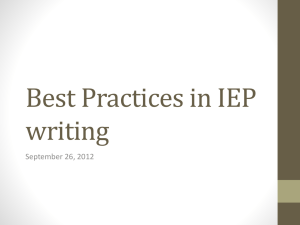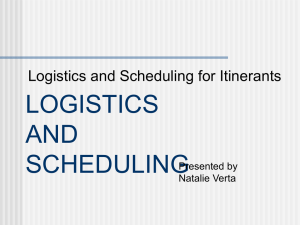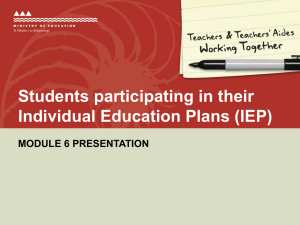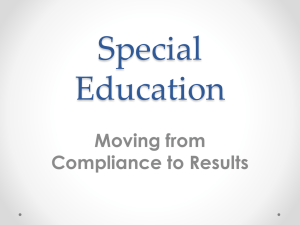ISMP Training Slides FINAL1
advertisement
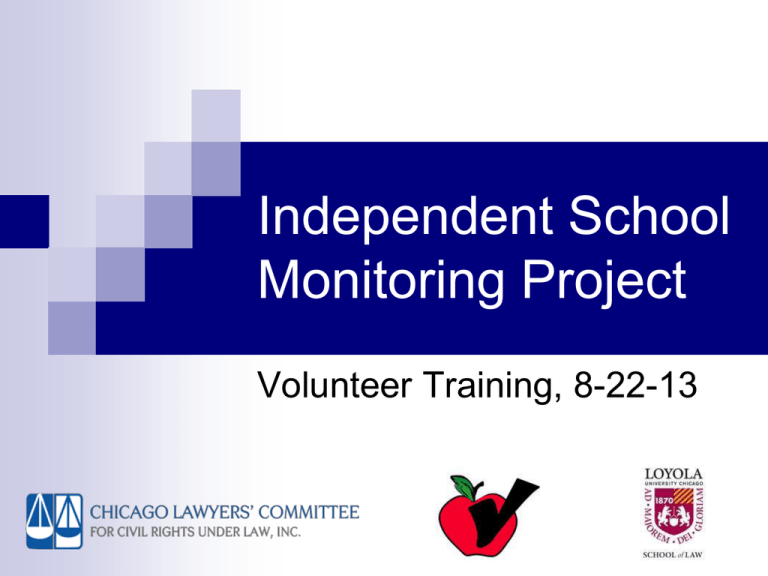
Independent School Monitoring Project Volunteer Training, 8-22-13 Agenda Introductions, purposes of the project School closings: the scope of the problem Legal rights of students at welcoming schools (including special education laws) Your job as a monitor Q&A Volunteer sign-ups Project Purposes & Goals What is the Independent School Monitoring Project? A joint effort of the Chicago Lawyers’ Committee for Civil Rights Under Law and the Education Law and Policy Institute at Loyola University Chicago School of Law The project is intended to assist in the orderly transition of children to new schools and ensure that their right to a high quality education is preserved during that process. Purposes of the Independent School Monitoring Project Monitoring where transition difficulties are occurring Providing legal referrals Distributing information to parents and students regarding their rights Collecting data and information so that identified problems can be resolved What the Project Will Do Provide trained volunteers at specific welcoming schools, both before and after school on the first two days of the school year, with possible additional days as-needed Collect information from volunteers to determine what issues need to be addressed Provide know your rights information to parents Our Concerns Whether CPS is following through on its commitments regarding the transition process and services provided at the welcoming schools Possible overcrowding of classrooms Whether closings will disrupt learning for Special Education Students or English Language Learners Whether student safety is being compromised Whether there are access or enrollment barriers for homeless, immigrant students or others School Closings: The Scope of the Problem Who is Affected? The largest closure of schools at one time in recorded US history 49 schools More than 13,000 students Overwhelmingly students from neighborhoods on the South and West Sides of Chicago Closing Schools – Affected Neighborhoods Impact on Protected Classes Impact on Homeless Students “All students are harmed by this chaos and destabilization and students who are homeless are particularly vulnerable to harm. The very cornerstone of homeless education law and policy is to provide stability in education to students who lack stable housing. The massive scale of CPS school actions undercut the very stability that students who are homeless so need and richly deserve.” Patricia Nix Hodes-Chicago Coalition for the Homeless School Closing Litigation CTU Federal Lawsuits State lawsuit over ten schools LAF lawsuit over closing of Trumbull Preliminary injunctions were denied in all four lawsuits Target Schools Independent hearing officers recommended that ten schools stay open and/or closings be delayed Other schools have been selected because they were identified by community members and others as being likely to have transition problems Students’ Rights During the Transition Process Rights of Students: Overview Federal Disability Law: ADA and IDEA McKinney-Vento Homeless Assistance Act Illinois School Code CPS Policies and Handbook Commitments by CPS in hearings and court proceedings Special Education Law Basics IEP = a plan created at least annually which lays out the educational goals and services to be provided to a student with a disability Federal and state law directs how IEPs are supposed to be created and implemented Special education includes a continuum of placements (classrooms), which could include A typical elementary classroom with accommodations and modifications A resource classroom with a special education teacher who provides targeted instruction to address needs A self-contained classroom only for students with disabilities Cluster programs to address the educational needs of students with low-incidence disabilities, such as autism or cognitive impairments Top Violation #1: Improperly Revising IEPs IEPs are supposed to be created by a team that includes parents and should be revised based on the needs of the student. IEPs for students entering welcoming schools may be revised improperly. Watch out for concerns about – IEPs that were revised to remove minutes of special education instruction IEP meetings that were held without the parent in attendance IEP meetings that were rushed without providing proper notice to the parent Requests for the parent to waive provision of services in a student’s IEP Top Violation #2: Not Providing IEP Services Schools are required to provide the educational services that are included in a student’s IEP. Welcoming schools may not provide the required IEP services. Some parents may know the services that are required in the IEP, others may not. Watch out for concerns about – A student who is not being supported by an aide that was at the previous school A student who is not getting to participate in the typical elementary classroom, but did at the old school A student with a behavior plan that is not being followed Top Violation #3: “Our School Doesn’t Do That” Education needs to be provided in accordance with a student’s IEP. Welcoming schools may claim they do not have the same classes or supports included in a student’s IEP, so they will not provide them. Watch out for concerns about – Anytime a parent tells you that they were told that the new school “doesn’t do that” Native language support (ie – Spanish) not being provided at the new school Top Violation #4: Not Providing Transportation Students with IEPs may be eligible for door-to-door transportation to the new school based on their IEPs or based on the nature of their disabilities. Transportation services may not be provided properly at the beginning of the school year. Watch out for concerns about – The bus not coming to pick the student up A student with an IEP not being able to walk to the new school The school not being willing to alter pick-up/drop-off at a daycare or babysitter Top Violation #5: Enrollment Students with IEPs are entitled to immediate enrollment at their neighborhood schools. Welcoming schools may create barriers for students whose parents did not follow the appropriate registration process. Watch out for concerns about – Students who are turned away at the door and told to return on another date Students who are sent to another school for enrollment Students who are turned away because the school is “full” Access and Enrollment Barriers Safe Passages From CPS Website: Chicago Public Schools will be expanding the Safe Passage program to 51 Welcoming Schools to support our students as they transition to their new schools this fall. Expanding the Safe Passage program to include next year’s welcoming schools is one of several steps CPS is taking to create safe environments in and around our schools. Safe Passage workers are the eyes and ears of their communities and will be our partners in providing safe routes to and from school every day for students. More info and find the route: http://www.cps.edu/Pages/safepassage.aspx Other Commitments by CPS Welcoming coffee sessions Ipads Community gardens Air conditioning in every building Libraries Other Issues to Flag Document any concerns raised by parents or students regarding their child’s education and/or the transition process to the new school Potential other issues include: pending school discipline, bullying, racial discrimination, transportation, ESL services, school transfer The School Monitoring Process Your job as a monitor Talk to parents and students Fill out short survey forms Distribute “know your rights” materials Conduct intakes Provide legal referrals as needed Materials provided to you Training manual Volunteer cover sheet Copies of survey form Copies of intake form “Know your rights” brochures and other flyers Yellow “MONITOR” button What’s in Your Training Manual? Welcome Note Safe Passages map of welcoming schools List of Schools and start Times Brief legal summary FAQ Copies of volunteer cover sheet, survey forms, and intake forms List of legal non-profit referral numbers List of frequently called CPS numbers Contact information for your Coordinators Preparing for Monitoring Bring your packet and monitor button Dress professionally (business casual) Prepare for the weather Determine how you will get to your assigned school Arrive fifteen minutes early in order to familiarize yourself with the school’s environment When You Get to Your School Selecting a spot to station yourself Start on the sidewalk in front of schools Do not go on the school grounds Make sure you are getting substantial traffic from parents and students Stand within eye distance of your partner, ideally facing each other Introducing Yourself Only approach parents You may mention that you are an attorney or law student (if applicable) Introduce yourself as part of the Independent School Monitoring Project. Make it clear that you are not affiliated with CPS Ask if their child formerly attended a closing school Ask if they would mind taking a few minutes to answer some questions about the school transition process. Filling out Your Volunteer Cover Sheet (insert a slide here about the cover sheet, like the one on the next page about survey forms) Filling out Survey Forms Address questions in order Get as much information as possible Conducting Longer Intakes Obtain as much information as possible – name, address, and phone number are important. Ideally get a back up phone number as well. You can’t guarantee anything but with permission can get the information to the right legal services organization Providing Legal Referrals Quick referral: school closure helpline (773) 8000-EDU Special Education Concerns Equip, LAF Homeless Students Chicago Coalition for the Homeless Legal Concerns Not Related to Education CARPLS If you are asked to leave School officials or police officers could conceivably ask you to stop talking to parents and students, even if you are not on school grounds If this happens, you should document the incident, but should leave school grounds. Call one of the organizers immediately after leaving In Closing Thank the parent and student for their time Remind them that you are not agreeing to represent them or to share their information Let them know that we may seek to followup on the information they provided if given permission to do so. Do NOT Approach students unaccompanied by a parent Enter the school building, or school grounds Escalate any situation Provide legal information or advice, or promise families that any organization will provide them with legal assistance Insist on staying at a school after being instructed to leave After you leave the school Once your shift is over, you are free to leave your school. Forms, including your cover sheet, your survey forms, and all longer intake forms should be scanned and emailed immediately upon return to schoolmonitoringproject@gmail.com (Loyola students can also bring them to the ChildLaw Center/11th Floor) Please note in the body of the e-mail if there are parents we should follow through with, or particular concerns about the school in question. Questions? Thank you for volunteering!



